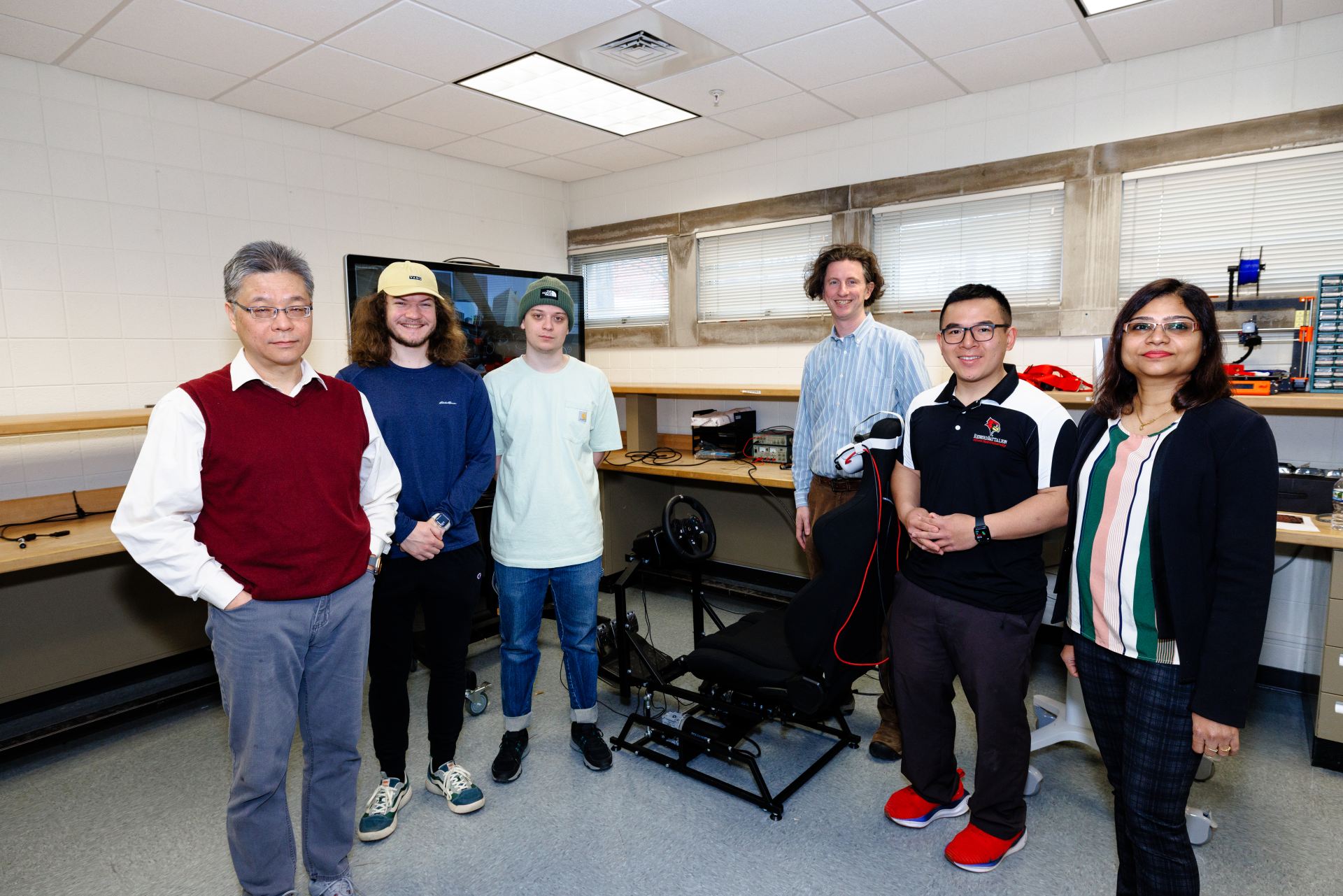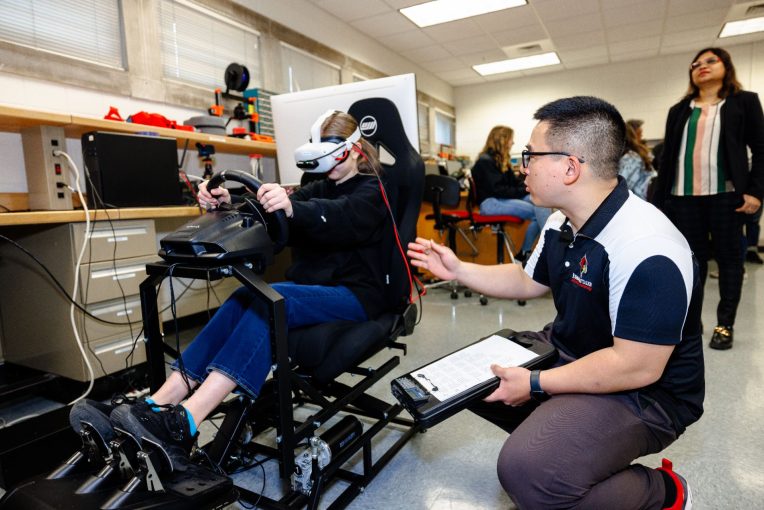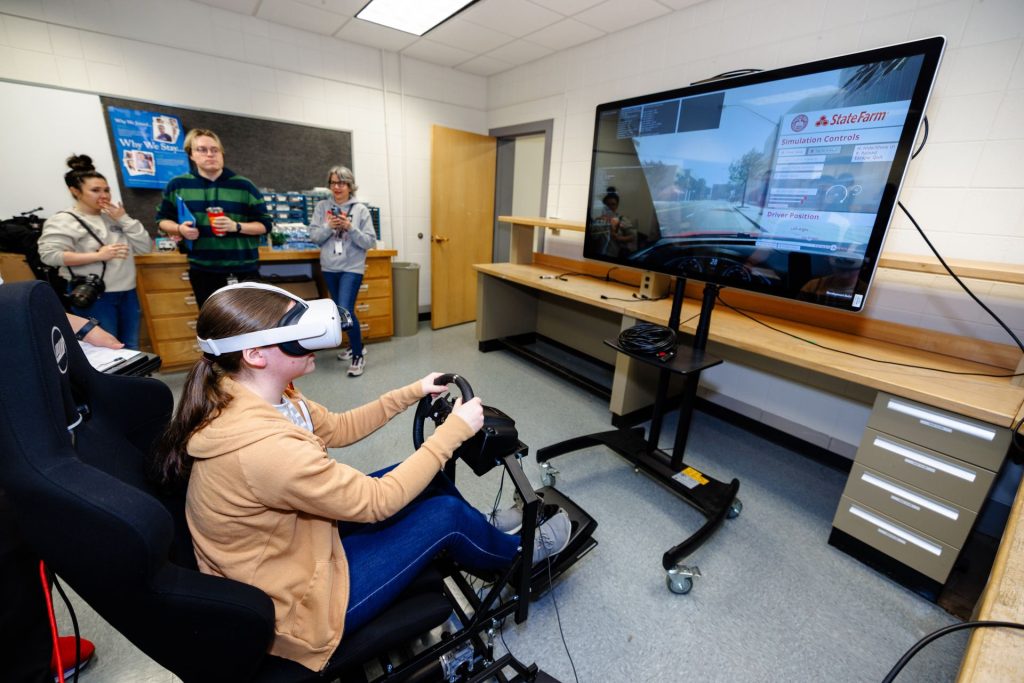Illinois State University and State Farm Insurance are using virtual reality (VR) to make teen drivers safer. A research project, titled Teen Driver Safety, places drivers in scenarios they may encounter on the road, like heavy traffic, unexpected deer crossings, and rolling fog.
The immersive VR platform allows a driving coach to configure different hazardous scenarios and highlight students’ deficiencies and successes in a post-session debriefing.
“The goal is to create a scenario-based learning environment where teen drivers can experience various road driving situations without being exposed to physical dangers,” said Dr. Isaac Chang, associate professor in Illinois State’s Department of Technology and the principal investigator on the project.

The two-year project launched last June and is being developed in two phases. First, the researchers created a minimum viable product for concept proofing.
“In this second phase, we are validating the system, developing appropriate learning assessments, and establishing the resemblance of user behavior and performance between simulated driving and actual driving,” Chang said.
State Farm, the largest insurer in the U.S., hopes the technology will lead to more safe drivers and a corresponding decrease in claims. But the company’s interest in the project goes beyond business reasons.
“Our collaboration with Illinois State University is centered around the safety of teen drivers and helping them gain valuable driving experience in a low-risk environment through the use of technology.”
Laurel Straub, State Farm
“Motor vehicle crashes are a leading cause of death for teen drivers in the U.S.,” said Laurel Straub, assistant vice president of Enterprise Research at State Farm. “Our collaboration with Illinois State University is centered around the safety of teen drivers and helping them gain valuable driving experience in a low-risk environment through the use of technology.”
State Farm’s Enterprise Research team members Jon Wey, Melissa Miles ’97, and Vince Hummel ’02, M.S. ’06, helped develop the project with Chang and co-investigator Dr. Roy Magnuson, a VR expert and an associate professor in the School of Music at Illinois State.
“We had been talking about doing something, and I asked Roy, ‘What about a driving simulator?’” Hummel said. “Roy was great, and he liked the idea, so I wrote up a proposal to my leadership. This has great potential. If a kid is in a dangerous situation when they’re driving, they can say, ‘Hey, I know what to do’ because of their VR experience.”
Charles Edamala, Illinois State’s chief technology officer and associate vice president for Technology Solutions, said his office works closely with large technology vendors and can be a vital link between industry and the University.
“Tech Solutions aids in mitigating the risks typically associated with new technology and investments, barriers that often impede innovation within larger corporations,” Edamala said. “These corporations can conduct prototyping initiatives through partnerships with ISU, gaining invaluable insights to steer their strategic planning more precisely.
“I appreciate that Melissa, Jon, and Vince recognized that ISU is a talent hotbed in their neighborhood and took the time to work with us.”
Taking a test drive
Magnuson and graduate assistants (GA) Zétény Nagy and Miles Howley (both from Creative Technologies) contributed to developing the VR prototype, which puts users in the driver’s seat. The prototype is equipped with a steering wheel and foot pedals for accelerating and braking, and users experience real-life driving conditions such as navigating heavy traffic and dodging wild animals that jump into their path.
Nathan Ji, a GA in the Department of Technology, coaches drivers on how to use the simulator, warning them about impending bad weather and reminding them to watch their blind spots. When Chang welcomed 12 freshmen and sophomores from Roanoke-Benson High School to his Turner Hall Lab on March 22 to test-drive the prototype, Ji was there to assist.
Grace Blunier, a freshman with her driver’s permit, took a turn. Once she got comfortable wearing the headset, her driving improved.
“It was nice to drive into situations that I’ll be seeing on the street and that I’d never seen before,” Blunier said. “As I got more comfortable, I could see the other traffic and the stop lights changing colors. It just took a little bit to get used to it.”
When students performed exceptionally well, Ji rewarded them with a high-five and a “great job!” Once done driving, students completed a survey about the VR experience to offer feedback.
Roanoke-Benson teacher Heatharlyne Wilkes said the event was amazing.
“It’s hard to get opportunities like this, and it’s a safe environment,” she said. “When you do something 20 times, you get an idea of what it looks like and learn muscle memory. I love this opportunity for our kids.”
Magnuson said the University is uniquely suited for these types of projects. Illinois State researchers were able to quickly build a prototype that is highly functional, adaptable, and complementary to the company’s needs, he said, adding that State Farm might have been challenged to develop something internally in such a short time frame.
“I am incredibly proud of the work we have done on this,” Magnuson said. “This has been by far the most complicated, stressful, intellectually challenging, and wildly interesting project I have ever been involved with.”
Chang said the partnership with State Farm goes beyond the company’s project sponsorship because both institutions share the same vision and goals.
“This project intends to deliver a product that benefits both State Farm and ISU,” he said. “State Farm can demonstrate its commitment to a safe driving environment while ISU faculty and students can work on authentic projects with industry leaders and bring the lessons learned to the classroom.”
Each of the following GAs had a role in the design of the VR simulator: Dolly Gupta (TEC), Miles Howley (CTK), Nathan Ji (TEC), Matthew Kase (CTK), Zétény Nagy (CTK), and Yaqoob Ayaan Ishaqui Syed (IT).


